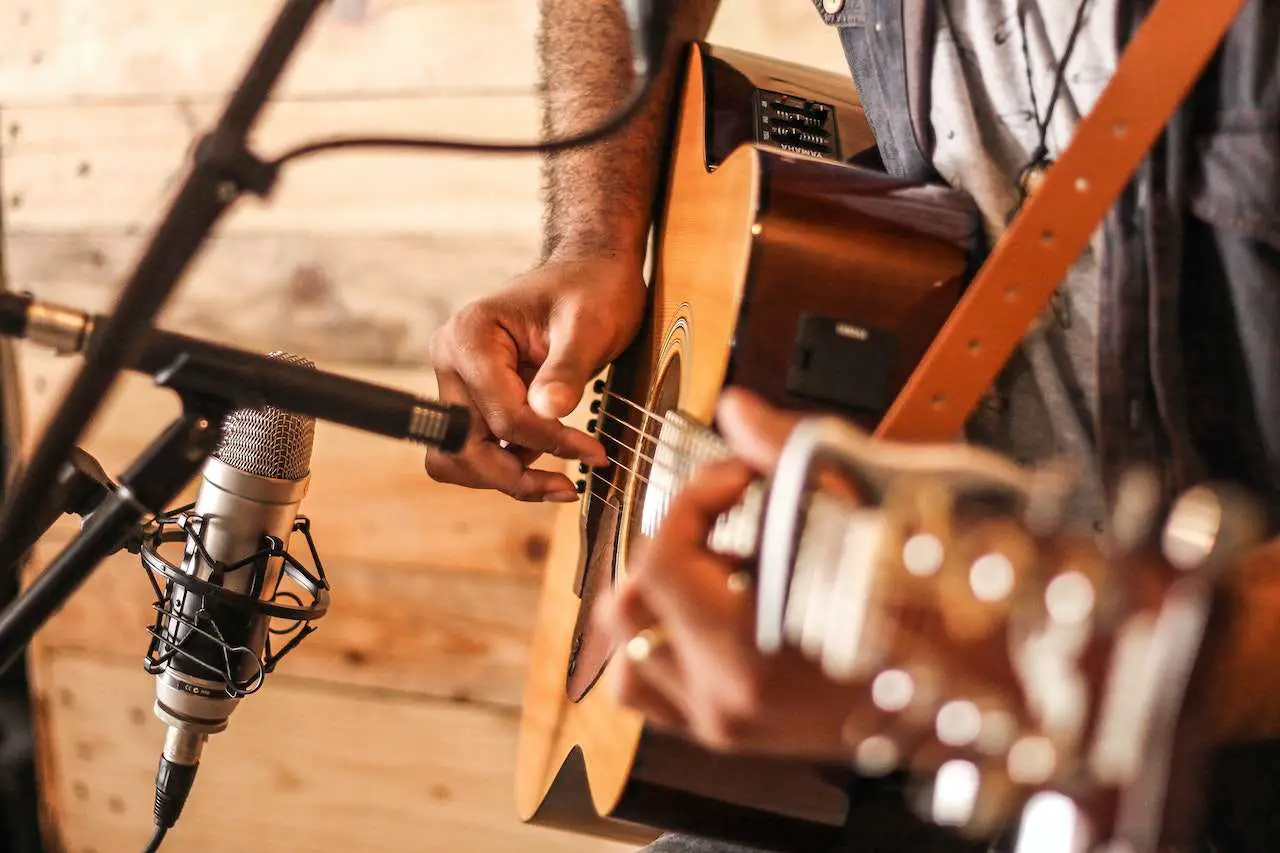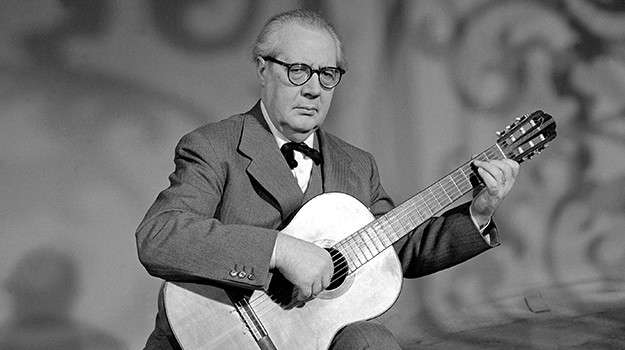An Arpeggio is when guitarists take chord notes and play them one after another instead of simultaneously strumming all the chord notes, they are sometimes referred to as broken chords. They have frequently been used in classical music, Jazz guitar solos, as a backing track in pop music, and sweep picking in metal music. Needless to say, playing arpeggios is easy and they sound great! Not to mention they make a great guitar warmup. In this article, we will discuss what is arpeggio on guitar, show you the arpeggio shapes, and how to play arpeggios.
Related: What are the string names on a guitar?

What is an Arpeggio, and what can it do for you?
The word arpeggio is derived from the Italian word Arpeggiare, which means ‘To play the Harp.’ Arpeggios, often known as a broken chord or arpeggiated chords, are all the notes of a chord that are not strummed together; instead, they are played individually.
To understand what an Arpeggio on guitar is, you must know what an Arpeggio can do for you. Arpeggios can develop a melodic and fast-paced sound. Since the Arpeggio comprises all the chord progression, you can use them as solos and link them with the chord structure.
Guitar arpeggios will always sound better over a particular chord progression, and they generally form the safe notes and melodic bases for improvising guitar players.
Related: Learn to play the B minor chord
Arpeggios vs Scale
Let’s first clear up all the confusion that people have between Arpeggios and Scales. Scales are note series played one by one and perfectly fit within a typical key signature. On the contrary, Arpeggios is a note series played one by one that consists of notes with a specific cord.
Arpeggios are linear, like a scale, and are note sets that guitarists play one at a time.
While scales sometimes comprise extra notes that aren’t always played in the chords, Arpeggio shapes only have the notes found in a single chord. You can play Arpeggios and Scale in an ascending, random, or descending order.
Understanding the notes of the major scale is important, because an arpeggio shape is just deciding to leave certain notes out.
Related: How to play the E Major scale

Shapes of Arpeggios
To fully grasp the concept & learn arpeggios on guitar, we will now discuss arpeggio shapes. Both Arpeggios and Scales have a wide array of shapes, but with Arpeggios, that are five caged shapes that you need to know.
You also need to learn Arpeggio from different guitar neck positions to become familiar with each shape and know which fret to put your fingers on. While you must understand all caged shapes, it is better to focus on one. You can practice by moving from one caged shape to another. Here are the chord shapes:
C Shape
This Arpeggio shape is derived from the C chord form but also consists of third, fifth on the sixth string, and fifth on the first string. The C shape is regularly used in music.
A Shape
The chord shape is derived from the A form chord. This shape also consists of fifth on the sixth string as well as the third on the fourth string.
G Shape
This shape is constructed from the G form Barre chord and consists of a fifth on the second string.
E Shape
This shape is from the E form Barre chord and consists of third on the fifth string. A portion of this shape is regularly used in music.
D Shape
This shape is developed in the D form chord and comprises additional notes such as third on the sixth string, fifth on the fifth string, and third on the third string. To play in its complete form, this is an awkward shape, and you will frequently observe only the fifth, root, and third played on strings one to three.
To learn more about the string letters check out our article here

Guitar arpeggios
Anytime you play the notes of a chord individually, you are playing an arpeggio. Arpeggios are a great tool to practice because they can be used to perfect a right hand picking technique, further understand the notes on the fret board, or understand the chords tones necessary for the chords you play. To really make the best of your arpeggio practice, try playing them all over the neck, and in as many keys as possible.
Arpeggio Shapes
By slowly playing the arpeggios note by note, you would eventually notice a pattern between the major and minor arpeggios. Here are some diagrams that show the difference:


These diagrams show 2 octave major and Minor arpeggios on guitar. This arpeggio shape will work all over the neck. Also note that you don’t need to use the notes in this order. You can implement arpeggio variations to really spice up your sound.
Major Arpeggio
A major arpeggio is the sound you get when you play all the notes of a major chord one by one.
In a major key, the I, IV, and V chords would all be major. So for these you would use a major arpeggio shape. To make a major arpeggio you play the tones 1, 3, 5, and sometimes 7. So for example, to play the C Major Arpeggio, you would play the notes C, E, G, and B. (If you wanted to add the 7th.) Notice that the C Major arpeggio has the same notes as a C Major chord!
Minor Arpeggios
When you play out the notes of a minor chord, you are now playing a minor arpeggio. In a Major key like C, the ii, iii, and vi chords would all be minor. So, you would play the chord tones 1, b3, 5, and 7. For example, to play the D minor arpeggio you would play the notes D, F, A, and C. (If you wanted to add the 7th.)

Chord Tones
For a major arpeggio, you want to play the root, third, and fifth. Or the 1, 3, and 5. (Adding the seventh is optional) For a minor arpeggio you want to play the root, b3, and 5. The only difference between the two is the lowered 3rd scale degree. A C major arpeggio would have the chord tones C, E, and G, whereas a C Minor arpeggio would have the notes C, Eb, and G.
Arpeggio and Triads
To completely grasp the concept of guitar Arpeggios, it is essential to know triads, which are three-note chords. You can develop a major triad by stacking a third of the major scale, which are the third and fifth notes and the root.
If a major triad consists of C#, E, and A, an A Major Arpeggio needs these notes to sound individually. For a triad that is minor, the third degree is flatted or lowered half a step. A triad considered minor would typically comprise E, C, and A. Another Arpeggio that you can practice is the major and minor seventh.
Importance of Intervals
Let’s take a step back and break the Arpeggios into intervals. There is a spatial relationship among the chord notes on the guitar’s fretboard, and rather than memorizing the Arpeggio patterns, it is essential to understand them.
By analyzing the chord shapes, you will notice a few patterns. Every interval (the relationship among scale or chord tone) is considered a spatial relationship. A fifth is two frets up the neck, and an Octave is two frets up and two strings below.
Three frets up on the exact string; you can find the minor thirds. The major thirds are found a fret up from the minor thirds, one fret down, or one string below. While the relationships can change, high E and B strings are involved due to the tuning, and you will get used to the intervals in the fretboard.

Which Arpeggio Should you learn First?
The major triad is the best Arpeggios to learn first. After the major triad, you can go for the minor triad. Both triads are the most used Arpeggios in the music industry. If the Arpeggio concept is new to you, you should always start and finish at the root because this will enable you to train your ears to hear the scale’s sound.
The Various Picking Styles
There are many ways of playing Arpeggios, tapping, sweep picking, pull-offs, hammer-ons, and legato are one of them. For experienced guitarists, lead techniques are used for playing Arpeggio at high speed, such as finger rolling and string skipping.
You can experiment with each picking style to see which one suits you the best. However, we will also like to add a few things about fingerpicking. While fingerpicking chords are Arpeggios, the individual notes aren’t usually muted and ring together since the chord tones are broken.
The listeners have no problem hearing the chord due to the vibration of every note. At any given time, there is only one Arpeggio note being played.

Conclusion
Whether you play electric, acoustic or classical, you can use arpeggios in your everyday playing! You can craft great sound from your guitar just by learning a few basic shapes.
In this article, we discussed what are arpeggios on guitar and how they are sometimes referred to as a broken chord. We touched upon various components of the Arpeggio, such as its shapes and patterns. We also explained how Arpeggios and scales differ to give our readers some much-needed clarity.
